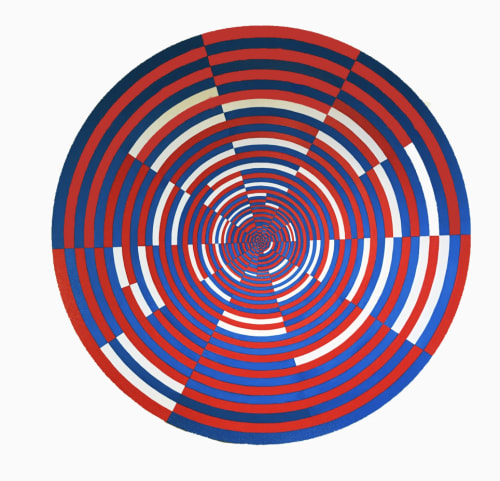“My work is a visual laboratory where each line, circle, and square becomes an experiment. I seek to create the illusion of movement within still forms, provoking a perceptual experience born in the gaze and imagination of the viewer.” — Youri Messen-Jaschin
Born in 1941 in Arosa, Switzerland, of Latvian origin, Youri Messen-Jaschin is a major figure of Op Art whose practice spans more than six decades. Based in Lausanne, he has consistently explored the boundaries between illusion, perceptual movement, geometry, and color. His early work in the 1960s already revealed this pioneering approach: his glass and acrylic sculptures were exhibited at the 1964 Swiss National Exhibition, signaling the emergence of an artist deeply engaged with optical phenomena.
Throughout his career, Messen-Jaschin has developed a multidisciplinary practice including sculpture, painting, installation, screenprinting, performance, and textile art. His work is grounded in the dynamic interaction between artwork and viewer, investigating not only what is seen but how the brain processes visual stimuli. This cognitive dimension culminated in his 2021 publication Op Art Meets Neuroscience, which bridges artistic experimentation and scientific insight.
Influences and encounters have played a key role in shaping his vision. Henry Moore introduced him to the expressive potential of sculptural form; Harald Szeemann and Christo’s wrapped Kunsthalle revealed the exhibition as an artistic gesture in itself; and Denise René’s impact at MoMA helped define the international language of Op Art. In the 1970s, he expanded his practice in Bern through painting, printmaking, performance, and tapestry, joined Idols, and later explored Arte Madí in Buenos Aires as well as experimental approaches to art in the United States.
“I see myself above all as a researcher in the art of movement,” he writes. For Messen-Jaschin, the process—testing, exploring, inventing impossible illusions—is at the heart of creation. His works aim not to convey a message but to generate a perceptual experience in which forms and colors seem to vibrate, creating the sensation of movement within stillness.
His works are held in major institutions, including Kunsthaus Zürich, the Orensanz Foundation in New York, Sakima Art Museum in Japan, and the Cabinet des estampes of the Musée d’art et d’histoire in Geneva.

